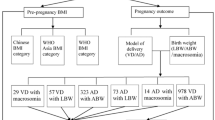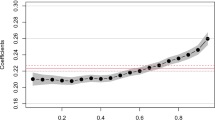Abstract
Objective:
The Institute of Medicine (IOM) 2009 gestational weight gain (GWG) guidelines are based on prepregnancy body mass index (BMI) categories. We intended to refine optimal GWG for each prepregnancy BMI unit in relation to the risk of small- and large-for-gestational-age (SGA and LGA) births, cesarean section (C-section) and infant death.
Study Design:
We used data from 836,841 Ohio birth records from 2006 to 2012, and applied generalized additive models to calculate optimal GWG by prepregnancy BMI unit.
Results:
The suggested optimal GWG was generally similar to IOM 2009 GWG guidelines for prepregnancy BMIs <25 kg m−2, but higher for prepregnancy BMIs 25 to 32 kg m−2 and lower for BMIs 38 to 50 kg m−2. The suggested optimal GWG was 14 to 18.5, 13 to 17, 11.5 to 16, 8.5 to 12.5, 4 to 10, 3 to 7, 1.5 to 6 and 1.5 to 4.5 kg for prepregnancy BMIs 15, 20, 25, 30, 35, 40, 45 and 50 kg m−2, respectively.
Conclusion:
This research suggests that GWG recommendations may be refined at individual prepregnancy BMI levels.
This is a preview of subscription content, access via your institution
Access options
Subscribe to this journal
Receive 12 print issues and online access
$259.00 per year
only $21.58 per issue
Buy this article
- Purchase on Springer Link
- Instant access to full article PDF
Prices may be subject to local taxes which are calculated during checkout



Similar content being viewed by others
References
Rasmussen KM, Yaktine AL (eds). Committee to Reexamine IOM Pregnancy Weight Guidelines; Institute of Medicine; National Research Council Weight Gain During Pregnancy: Reexamining the Guidelines. National Academies Press: Washington, DC, 2009.
Chen A, Xu F, Xie C, Wu T, Vuong AM, Miao M et al. Gestational weight gain trend and population attributable risks of adverse fetal growth outcomes in Ohio. Paediatr Perinat Epidemiol 2015; 29 (4): 346–350.
Siega-Riz AM, Deierlein A, Stuebe A . Implementation of the new institute of medicine gestational weight gain guidelines. J Midwifery Womens Health 2010; 55 (6): 512–519.
Bodnar LM, Abrams B, Bertolet M, Gernand AD, Parisi SM, Himes KP et al. Validity of birth certificate-derived maternal weight data. Paediatr Perinat Epidemiol 2014; 28 (3): 203–212.
Park S, Sappenfield WM, Bish C, Bensyl DM, Goodman D, Menges J . Reliability and validity of birth certificate prepregnancy weight and height among women enrolled in prenatal WIC program: Florida, 2005. Matern Child Health J 2011; 15 (7): 851–859.
Wright CS, Weiner M, Localio R, Song L, Chen P, Rubin D . Misreport of gestational weight gain (GWG) in birth certificate data. Matern Child Health J 2012; 16 (1): 197–202.
Chen A, Feresu SA, Fernandez C, Rogan WJ . Maternal obesity and the risk of infant death in the United States. Epidemiology 2009; 20 (1): 74–81.
Hutcheon JA, Bodnar LM, Joseph KS, Abrams B, Simhan HN, Platt RW . The bias in current measures of gestational weight gain. Paediatr Perinat Epidemiol 2012; 26 (2): 109–116.
Oken E, Kleinman KP, Rich-Edwards J, Gillman MW . A nearly continuous measure of birth weight for gestational age using a United States national reference. BMC Pediatr 2003; 3: 6.
Hastie T, Tibshirani R . Generalized additive models. Stat Sci 1986; 1 (3): 297–318.
Hastie T, Tibshirani R . Generalized additive models for medical research. Stat Methods Med Res 1995; 4 (3): 187–196.
Kotelchuck M . An evaluation of the Kessner Adequacy of Prenatal Care Index and a proposed Adequacy of Prenatal Care Utilization Index. Am J Public Health 1994; 84 (9): 1414–1420.
Ingram DD, Franco SJ . 2013 NCHS urban-rural classification scheme for counties. Vital Health Stat 2014; 2 (166): 1–73.
Johnson J, Clifton RG, Roberts JM, Myatt L, Hauth JC, Spong CY et al. Pregnancy outcomes with weight gain above or below the 2009 Institute of Medicine guidelines. Obstet Gynecol 2013; 121 (5): 969–975.
Vesco KK, Sharma AJ, Dietz PM, Rizzo JH, Callaghan WM, England L et al. Newborn size among obese women with weight gain outside the 2009 Institute of Medicine recommendation. Obstet Gynecol 2011; 117 (4): 812–818.
Park S, Sappenfield WM, Bish C, Salihu H, Goodman D, Bensyl DM . Assessment of the Institute of Medicine recommendations for weight gain during pregnancy: Florida, 2004-2007. Matern Child Health J 2011; 15 (3): 289–301.
R Development Core TeamR: A Language and Environment for Statistical Computing. R Foundation for Statistical Computing, Vienna, Austria, 2004. ISBN 3-900051-07-0. http://www.R-project.org.
Pitkin RM . Nutritional support in obstetrics and gynecology. Clin Obstet Gynecol 1976; 19 (3): 489–513.
Hutcheon JA, Bodnar LM . A systematic approach for establishing the range of recommended weight gain in pregnancy. Am J Clin Nutr 2014; 100 (2): 701–707.
Potti S, Sliwinski CS, Jain NJ, Dandolu V . Obstetric outcomes in normal weight and obese women in relation to gestational weight gain: comparison between Institute of Medicine guidelines and Cedergren criteria. Am J Perinatol 2010; 27 (5): 415–420.
Kominiarek MA, Seligman NS, Dolin C, Gao W, Berghella V, Hoffman M et al. Gestational weight gain and obesity: is 20 pounds too much? Am J Obstet Gynecol 2013; 209 (3): 214.e211–211.
Bodnar LM, Siega-Riz AM, Simhan HN, Himes KP, Abrams B . Severe obesity, gestational weight gain, and adverse birth outcomes. Am J Clin Nutr 2010; 91 (6): 1642–1648.
Langford A, Joshu C, Chang JJ, Myles T, Leet T . Does gestational weight gain affect the risk of adverse maternal and infant outcomes in overweight women? Matern Child Health J 2011; 15 (7): 860–865.
Durie DE, Thornburg LL, Glantz JC . Effect of second-trimester and third-trimester rate of gestational weight gain on maternal and neonatal outcomes. Obstet Gynecol 2011; 118 (3): 569–575.
Margerison-Zilko CE, Shrimali BP, Eskenazi B, Lahiff M, Lindquist AR, Abrams BF . Trimester of maternal gestational weight gain and offspring body weight at birth and age five. Matern Child Health J 2012; 16 (6): 1215–1223.
Martin JA, Hamilton BE, Ventura SJ, Osterman MJ, Mathews TJ . Births: final data for 2011. Natl Vital Stat Rep 2013; 62 (1): 1–69 72.
Davis RR, Hofferth SL, Shenassa ED . Gestational weight gain and risk of infant death in the United States. Am J Public Health 2014; 104 (Suppl 1): S90–S95.
Hinkle SN, Sharma AJ, Swan DW, Schieve LA, Ramakrishnan U, Stein AD . Excess gestational weight gain is associated with child adiposity among mothers with normal and overweight prepregnancy weight status. J Nutr 2012; 142 (10): 1851–1858.
Baptiste-Roberts K, Nicholson WK, Wang NY, Brancati FL . Gestational diabetes and subsequent growth patterns of offspring: the National Collaborative Perinatal Project. Matern Child Health J 2012; 16 (1): 125–132.
Acknowledgements
The research work was partially supported by grants from National Institutes of Health (R01ES020349, RC4ES019755, P30ES006096), Perinatal Institute, Cincinnati Children’s Hospital Medical Center, Cincinnati, OH, and March of Dimes Grant 22-FY13-543 for the March of Dimes Prematurity Research Center Ohio Collaborative.
Author information
Authors and Affiliations
Corresponding author
Ethics declarations
Competing interests
The authors declare no conflict of interest.
Additional information
Supplementary Information accompanies the paper on the Journal of Perinatology website
Supplementary information
Rights and permissions
About this article
Cite this article
Chen, A., Xie, C., Vuong, A. et al. Optimal gestational weight gain: prepregnancy BMI specific influences on adverse pregnancy and infant health outcomes. J Perinatol 37, 369–374 (2017). https://doi.org/10.1038/jp.2016.267
Received:
Revised:
Accepted:
Published:
Issue Date:
DOI: https://doi.org/10.1038/jp.2016.267
This article is cited by
-
A prospective analysis of optimal total weight gain ranges and trimester-specific weight gain rates for Chinese pregnant women
BMC Pregnancy and Childbirth (2023)



